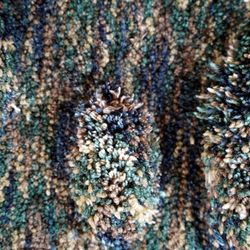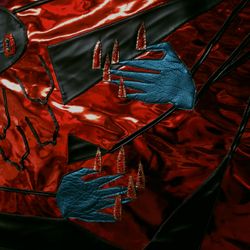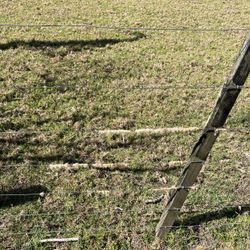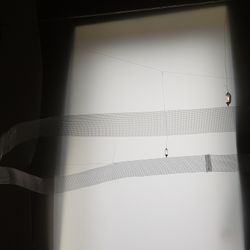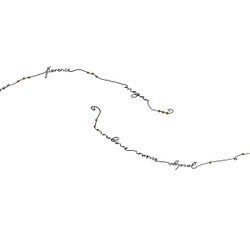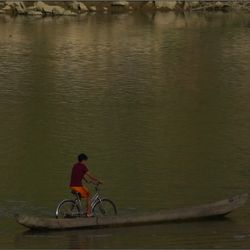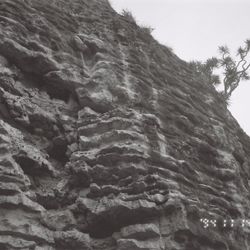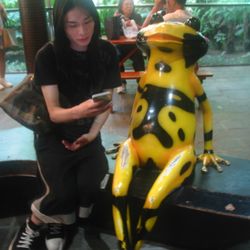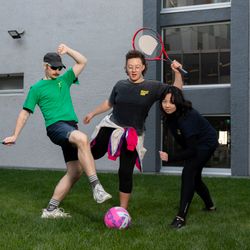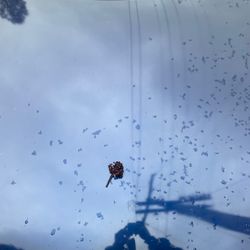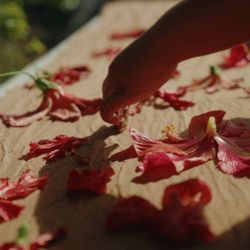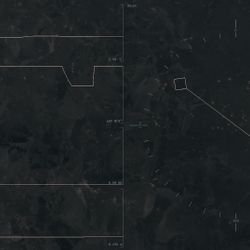Kia ora does not just mean hello or thank you. More deeply, it means to see; I see you, all of you. It acknowledges presence and mana. This is an exhibition to say: ‘I see you, mother.’
Kia ora Whaea presents new work by Alix Ashworth, Caitlin Rose Donnelly, Emma Kitson, and Kate Stevens West.
Past Exhibition
Hātarei 17 Hepetema -
Hātarei 22 Oketopa
Saturday 17 September -
Saturday 22 October
2022
This project was developed after the artists were introduced through Paemanu: Tauraka Toi - A Landing Place, a landmark exhibition featuring works and performances by more than 40 Kāi Tahu artists at Dunedin Public Art Gallery between 11 December 2021 - 25 April 2022.
Thank you to Mothers Matter, Hākui, and Otago Museum for their support of Kia ora Whaea.
Mothers Matter is a collaboration of committed individuals, health professionals, and parents who are united in a common goal to improve perinatal care for all women in New Zealand. Equity of care is what’s needed, we are clear that mothers should have the right to choose their birthing and postnatal care and needs.
Hākui is an online resource to connect Kāi Tahu whānau with our tīpuna knowledge and practices relating to pregnancy, birthing, as well as the much needed support tools for whānau who have lost babies through miscarriage or still birth. This resource springs from the PhD research of Kelly Tikao, and has been created in collaboration with Kāi Tahu midwives, whānau, hākui, and tāua who wish to support the revival of our customary practices relating to Hākuitaka. The oriori which provide the soundtrack to Kia ora Whaea were beautifully recorded and provided by Hākui.
Installation view, 2022. Photo: Rosa Nevison
Kate Stevens West, left to right, Moe 1, 2022, oil paint on unstretched canvas, brass eyelets 55x70cm
Moe 2, 2022, oil paint on unstretched canvas, brass eyelets 55x70cm Photo: Rosa Nevison
Alix Ashworth, all work pictured, Te Kore (it began with a miscarriage), 2022, Machine knitted red and orange wool, glass beads, fine spun steel, 60x 200cm.
Te Ao Mārama? (false trust in a medical system), Hand blended and handspun alpaca+silk+polwarth, Fine red wool, Salt fired porcelain, Nappy pin , 52x 110cm.
Te Ao Whenua (a chance to heal), 2022, Hand dyed + hand felted Corridale fleece, Carpet wool, Seeds, 52x 110cm. Glazed ceramic pēpē taniwha, 20x 18x 10cm.
Photo: Rosa Nevison
Alix Ashworth, Glazed ceramic pēpē taniwha, 20x 18x 10cm. Photo: Rosa Nevison
Alix Ashworth, detail of Te Ao Whenua (a chance to heal), 2022, Hand dyed + hand felted Corridale fleece, Carpet wool, Seeds, 52x 110cm. Photo: Rosa Nevison
Emma Kitson, Maku koe e tāwharautia. (Tōtara) I will shelter you, 2022, extra thick kozo paper dyed with tea and relief printed with waterbased inks, 400x1200mm. Photo: Rosa Nevison
Emma Kitson, Maku koe e tāwharautia. (Tōtara) I will shelter you, 2022, extra thick kozo paper dyed with tea and relief printed with waterbased inks, 400x1200mm. Photo: Rosa Nevison
Emma Kitson, I te māra o te pō. (Tākata Wairua) In the night garden, 2022, rice paper with rice paste and various pigments, watercolour etc, 1060x1450mm. Photo: Rosa Nevison
Caitlin Rose Donnelly, Kia ora Whaea, 2022, cloth nappies, sheets and acrylic paint, 170x 170cm. Photo: Rosa Nevison
Kate Stevens West, left to right,Taurewarewa 1 Hine Whakana, 2022, oil paint, kokowai, traditional ink on unstretched canvas, 42x138 cm
Taurewarewa 2 Irihapeti, 2022, oil paint, kokowai, traditional ink on unstretched canvas, 42x138 cm
Taurewarewa 3, 2022, oil paint, kokowai, traditional ink on unstretched linen, 42x138cm. Photo: Rosa Nevison
Installation view, 2022. Photo: Rosa Nevison
Installation view, 2022. Photo: Rosa Nevison
Kate Stevens West, left to right, Moe 1, 2022, oil paint on unstretched canvas, brass eyelets 55x70cm
Moe 2, 2022, oil paint on unstretched canvas, brass eyelets 55x70cm Photo: Rosa Nevison
Alix Ashworth, all work pictured, Te Kore (it began with a miscarriage), 2022, Machine knitted red and orange wool, glass beads, fine spun steel, 60x 200cm.
Te Ao Mārama? (false trust in a medical system), Hand blended and handspun alpaca+silk+polwarth, Fine red wool, Salt fired porcelain, Nappy pin , 52x 110cm.
Te Ao Whenua (a chance to heal), 2022, Hand dyed + hand felted Corridale fleece, Carpet wool, Seeds, 52x 110cm. Glazed ceramic pēpē taniwha, 20x 18x 10cm.
Photo: Rosa Nevison
Alix Ashworth, Glazed ceramic pēpē taniwha, 20x 18x 10cm. Photo: Rosa Nevison
Alix Ashworth, detail of Te Ao Whenua (a chance to heal), 2022, Hand dyed + hand felted Corridale fleece, Carpet wool, Seeds, 52x 110cm. Photo: Rosa Nevison
Emma Kitson, Maku koe e tāwharautia. (Tōtara) I will shelter you, 2022, extra thick kozo paper dyed with tea and relief printed with waterbased inks, 400x1200mm. Photo: Rosa Nevison
Emma Kitson, Maku koe e tāwharautia. (Tōtara) I will shelter you, 2022, extra thick kozo paper dyed with tea and relief printed with waterbased inks, 400x1200mm. Photo: Rosa Nevison
Emma Kitson, I te māra o te pō. (Tākata Wairua) In the night garden, 2022, rice paper with rice paste and various pigments, watercolour etc, 1060x1450mm. Photo: Rosa Nevison
Caitlin Rose Donnelly, Kia ora Whaea, 2022, cloth nappies, sheets and acrylic paint, 170x 170cm. Photo: Rosa Nevison
Kate Stevens West, left to right,Taurewarewa 1 Hine Whakana, 2022, oil paint, kokowai, traditional ink on unstretched canvas, 42x138 cm
Taurewarewa 2 Irihapeti, 2022, oil paint, kokowai, traditional ink on unstretched canvas, 42x138 cm
Taurewarewa 3, 2022, oil paint, kokowai, traditional ink on unstretched linen, 42x138cm. Photo: Rosa Nevison
Installation view, 2022. Photo: Rosa Nevison
Emma Kitson (Kāi Tahu, Kāti Māmoe, Waitaha) is an Artist, Designer and Curator who resides in Whanganui a Tara (Wellington). Her whakapapa traces its roots to Whenua Hou, the first planned bicultural settlement at the southern end of Te Waipounamu. Graduating from Dunedin School of Fine Art in 1996 she regularly exhibited at the Blue Oyster Gallery. Kitson then worked at Otago Museum which led to employment at many museums and art galleries in New Zealand and Australia. After studying Industrial Design at Massey University in the early 2000's she focussed mainly on her design work. Becoming a mother in 2012 was a catalyst for Kitson to return to making art and found printmaking to be the most accessible option. Joining Paemanu, Kāi Tahu Contemporary Artists in 2014, she has been a contributing artist in their major exhibitions at COCA and Dunedin Public Art Gallery.
Caitlin Rose Donnelly (Kāi Tahu, Kāti Mamoe, Pākehā) is a contemporary artist who works in various media, processes and scales, including drawing, painting, textiles and jewellery. Her practice is concerned with researching obstructions in identity. Her work often transforms rapidly, as her practice is process-driven. Her latest works have been large scale textile installations working within a kaupapa Māori framework. She holds a Master of Fine Arts from Dunedin School of Art and lives in rural Southland with her husband and two children.
Kate Stevens West (Kāi Tahu, Pākehā) is a painter. She paints family, the connections, the needs, and emotions, intergenerational secrets and stories. Stevens West paints the everyday; mess and messiness. Recent work explores Kāi Tahutaka working with historical research, traditional paints and pigments. Stevens West lives in Te Awakairangi (Lower Hutt) with her partner and four young children.
Alix Ashworth (Kāi Tahu, Kāti Māmoe, Waitaha) A multi media artist based in Ōtautahi. Their art practice discusses identity and belonging focusing on strong narrative using personal reflection to influence their creative process. After studying Fine Arts at Canterbury University they moved through a range of craft skills in order to be able to create works that celebrate historical knowledge of indigenous and non indigenous hand work. Their main medium is uku (clay), using this medium they contrast this hard media with soft hand stitched or hand woven textiles. It is important to their art practice that a majority of the work and materials are hand made, for example wool that is used in a woven pieces will be carded and hand spun by the artist before being woven into cloth.
